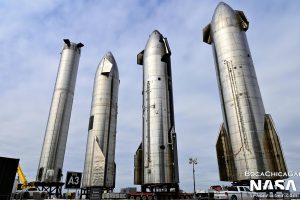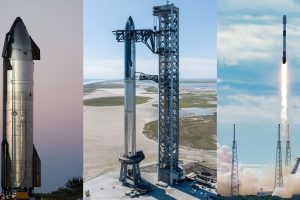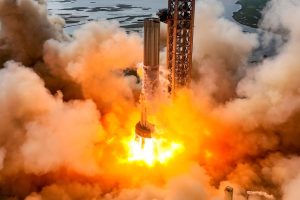SpaceX may be focused on preparing Starship S24 and Super Heavy Booster 7 for their potentially imminent orbital launch debut, but the rest of the company’s Starship factory isn’t just sitting around.
The laser focus on carefully testing Ship 24 and Booster 7 may have limited the effectiveness of Starbase rocket production, but the factory has continued to produce new ships and boosters. SpaceX has even conducted some limiting testing of a pair of prototypes meant to follow in the footsteps of S24 and B7. In mid-January, that process entered a new and more active phase as SpaceX transported Starship S25 from the factory to the launch pad.
The trip is not Ship 25’s first. Starship S25 first headed to SpaceX’s South Texas launch and test facilities on October 19th, 2022, shortly after the vehicle was fully assembled. Around three weeks of testing followed, and now Ship 25 is back for more.
SHIP 25
The first round of tests was thorough and put Ship 25 through a pneumatic proof test, multiple cryogenic proof tests, and likely a few simulated thrust tests using six hydraulic rams.
“Ship 25 was removed from SpaceX’s other Starship test stand on November 8th, it was rolled back to Starbase’s Starship factory. Ship 25 first rolled to the launch site on October 19th and has since completed four visible tests. On October 28th, Ship 25 survived a pneumatic proof test that showed that its tanks were leak-free and capable of surviving flight pressures (roughly 6-8.5 bar or 90-125 psi). Three cryogenic proof tests followed on November 1st, 2nd, and 7th. The first cryoproof was likely just that – a test that pressurized Ship 25’s tanks and filled them with cryogenic liquid nitrogen (LN2) or a combination of liquid oxygen and LN2.
The next two tests likely took advantage of the customized test stand, which has been semi-permanently outfitted with a set of hydraulic rams that allow SpaceX to simulate the thrust of six Raptor engines while Starship’s structures are chilled to cryogenic temperatures and loaded with roughly 1000 tons (~2.2M lb) of cryogenic fluids. If a Starship can survive those stresses on the ground, the assumption is that it will likely survive similar stresses in flight.”
Teslarati.com – October 20th, 2022
As usual, SpaceX didn’t comment on the development or indicate how that initial proof testing had gone, but Ship 25’s January 14th, 2023 return to the launch site all but guaranteed that that testing had gone more or less according to plan. On January 17th, SpaceX lifted Ship 25 onto Starbase’s only Starship static fire test stand, further confirming that Ship 25 proof testing went to plan.
Soon after its November 2022 return to Starbase’s build site, six Raptor engines were moved into the High Bay and installed on Ship 25. The Starship’s aft was then likely buttoned up with a heat shield before it headed to the test site to begin its static fire test campaign. That campaign could tell us a lot about the status of Starship prototypes. To date, only two Ships have completed full six-Raptor static fire tests, and both took days, weeks, or months to build up to those six-engine milestones with multiple smaller tests. If Ship 25 were to skip those preliminary tests and immediately conduct a six-engine static fire, it would be a sign that SpaceX is significantly more confident in the current Starship design.
BOOSTER 9
Ship 25 is believed to be paired with Super Heavy Booster 9, which recently finished its own round of proof tests. About two months behind Ship 25, Booster 9 rolled out of its Starbase assembly bay and headed to the launch site on December 15th, 2022. The Super Heavy prototype ultimately completed two partial cryogenic proof tests on December 21st and 29th, during which it was likely loaded with around a thousand tons of liquid nitrogen to simulate explosive liquid oxygen and methane propellant. Booster 9 then returned to Starbase’s factory on January 10th, 2023.
Assuming those tests went well, Raptor engine installation could begin at any moment. However, thanks to significant design changes and upgrades present on Booster 9, outfitting and testing this Super Heavy could take longer than usual. Many smaller changes are present, but the most significant by far is the addition of an upgraded version of Raptor. The engine’s combustion-related hardware is likely the same as the Raptor V2 engines present on Booster 7, Ship 24, and Ship 25. But the hardware used to steer each engine – called thrust vector control (TVC) – has been completely changed.
Instead of using a complex web of plumbing and hydraulic power units bolted to the side of Super Heavy, Booster 9’s 13 central Raptors will be electrically steered. That has allowed SpaceX to remove those power units (streamlining Booster 9’s exterior) and reduce the already rats nest of plumbing required to fuel, control, power, and steer dozens of high-performance rocket engines on one booster. SpaceX has been testing electric Raptor TVC for months at its McGregor, Texas development facilities, but it’s unclear if the new technology has progressed to the point that 13 upgraded engines are ready to be installed on Booster 9. In the meantime, SpaceX may install Booster 9’s fixed outer ring of 20 Raptor V2 engines – none of which gimbal or need new electric TVC hardware.
Once all 33 engines are installed, it’s likely that Booster 9 will be thoroughly tested to ensure that all 13 electrically-steered engines work well together before, during, and after numerous static fire tests. SpaceX will also need to verify that the batteries likely powering those new systems function as expected. During the peak stresses they will likely experience, the electric TVC could need to rapidly redirect more than 3000 tons (~6.6 million lbf) of thrust multiple times per second. The peak power required from Super Heavy’s batteries will likely be immense as a result.
For now, the start of Super Heavy B9’s own static fire test campaign could be months away and will have to wait until Starbase’s only orbital launch mount – currently occupied by Booster 7, Ship 24, and Starship’s first orbital launch campaign – is vacated. With that orbital launch debut unlikely to happen before March 2023, Booster 9 has plenty of time to relax inside Starbase’s Wide Bay while Ship 25 begins static fire testing at a separate stand.





